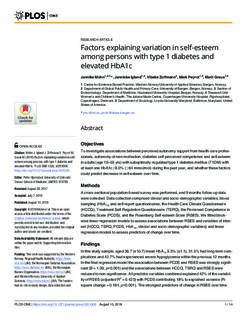| dc.contributor.author | Mohn, Jannike | |
| dc.contributor.author | Igland, Jannicke | |
| dc.contributor.author | Zoffmann, Vibeke | |
| dc.contributor.author | Peyrot, Mark | |
| dc.contributor.author | Graue, Marit | |
| dc.coverage.spatial | Norway | nb_NO |
| dc.date.accessioned | 2019-01-30T10:00:18Z | |
| dc.date.available | 2019-01-30T10:00:18Z | |
| dc.date.created | 2018-09-13T13:45:17Z | |
| dc.date.issued | 2018 | |
| dc.identifier.citation | Mohn, J., Igland, J., Zoffmann, V., Peyrot, M., & Graue, M. (2018). Factors explaining variation in self-esteem among persons with type 1 diabetes and elevated HbA1c. Plos One, 13(8), 1-14. | nb_NO |
| dc.identifier.issn | 1932-6203 | |
| dc.identifier.uri | http://hdl.handle.net/11250/2583027 | |
| dc.description.abstract | Objectives
To investigate associations between perceived autonomy support from health-care professionals, autonomy-driven motivation, diabetes self-perceived competence and self-esteem in adults (age 18–55 yrs) with suboptimally regulated type 1 diabetes mellitus (T1DM) with at least one HbA1c≥8.0% (≥64 mmol/mol) during the past year, and whether these factors could predict decrease in self-esteem over time.
Methods
A cross-sectional population-based survey was performed, and 9 months follow-up data were collected. Data collection comprised clinical and socio-demographic variables, blood sampling (HbA1c) and self-report questionnaires; the Health Care Climate Questionnaire (HCCQ), Treatment Self-Regulation Questionnaire (TSRQ), the Perceived Competence in Diabetes Scale (PCDS), and the Rosenberg Self-esteem Scale (RSES). We fitted block-wise linear regression models to assess associations between RSES and variables of interest (HCCQ, TSRQ, PCDS, HbA1c, clinical and socio-demographic variables) and linear regression models to assess predictors of change over time.
Findings
In this study sample, aged 36.7 (±10.7) mean HbA1c 9.3% (±1.1), 31.5% had long-term complications and 42.7% had experienced severe hypoglycemia within the previous 12 months. In the final regression model the association between PCDS and RSES was strongly significant (B = 1.99, p<0.001) and the associations between HCCQ, TSRQ and RSES were reduced to non-significance. All predictor variables combined explained 42% of the variability of RSES (adjusted R2 = 0.423) with PCDS contributing 18% to explained variance (R-square change = 0.184, p<0.001). The strongest predictors of change in RSES over time were long-term complications (B = 2.76, p<0.001), specifically foot-related problems, and being female (B = -2.16, p = 0.002).
Conclusions
Perceived autonomy support, autonomy-driven motivation and diabetes self-perceived competence play a significant role in explaining self-esteem among adults with suboptimally regulated T1DM. Healthcare professionals should acknowledge self-esteem as a valuable factor in understanding the multifaceted health choices people with T1DM make. | nb_NO |
| dc.language.iso | eng | nb_NO |
| dc.publisher | PLoS | nb_NO |
| dc.rights | Navngivelse 4.0 Internasjonal | * |
| dc.rights.uri | http://creativecommons.org/licenses/by/4.0/deed.no | * |
| dc.title | Factors explaining variation in self-esteem among persons with type 1 diabetes and elevated HbA1c | nb_NO |
| dc.type | Journal article | nb_NO |
| dc.type | Peer reviewed | nb_NO |
| dc.description.version | publishedVersion | nb_NO |
| dc.rights.holder | © 2018 Mohn et al. | nb_NO |
| dc.subject.nsi | VDP::Medisinske Fag: 700::Klinisk medisinske fag: 750::Endokrinologi: 774 | nb_NO |
| dc.source.pagenumber | 14 | nb_NO |
| dc.source.volume | 13 | nb_NO |
| dc.source.journal | PLoS ONE | nb_NO |
| dc.source.issue | 8 | nb_NO |
| dc.identifier.doi | 10.1371/journal.pone.0201006 | |
| dc.identifier.cristin | 1609212 | |
| cristin.unitcode | 203,3,20,0 | |
| cristin.unitname | Senter for kunnskapsbasert praksis - Bergen | |
| cristin.ispublished | true | |
| cristin.fulltext | original | |
| cristin.qualitycode | 1 | |

